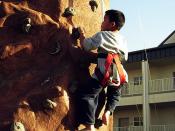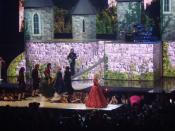The story is told from the perspective of the adult narrator looking back on a key incident from her early childhood in which she and her neighbourhood were threatened by the unpredictable aggression of the local "bogeyman" ironically named Fearless.
The first level of conflict in "Fearless" is between the public and Fearless. This arises out of Fearless's lack of respect for the "norm" of society. He is extremely rude and aggressive "...he lived in a state of permanent anger." and "He would stop, stiffen, shout and attack." This gives us an idea of his gratuitous antagonism and violence.
Galloway gives many such descriptive examples of how Fearless contrasts against the expected rules of acceptable society. Despite the fact that he is a rude, unhygienic and violent drunk, the people capable of stopping him don't. The men in the "pubs, barbers and bookies" "never shut him up when the anger started."
Although they could have easily protected the women and children by subduing Fearless when the anger started, they didn't.
Much time is taken on the intensive description of Fearless's character. He is not initially named in paragraph one. This makes Galloway's use of 'he' seem much more mysterious and threatening helping to build up the malevolence of this character. This effect is also achieved by the statement "you laughed at him behind his back," implying a bogeyman character that no one would dare laugh at in front of. The use of the word 'specimen' in the line "Fearless was a very wee man in a greasy gabardine coat made for a much bigger specimen altogether," portrays Fearless as non-human or the subject of some sort of judgement or experiment as well as alienating him from the rest of the world. The physical description of him helps us build...


